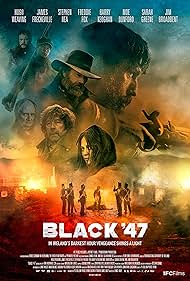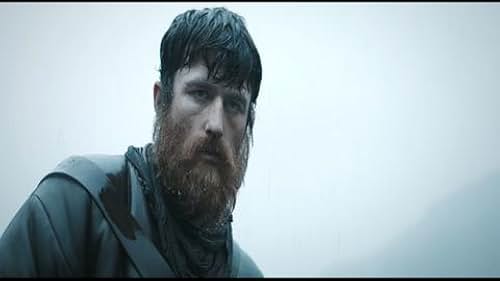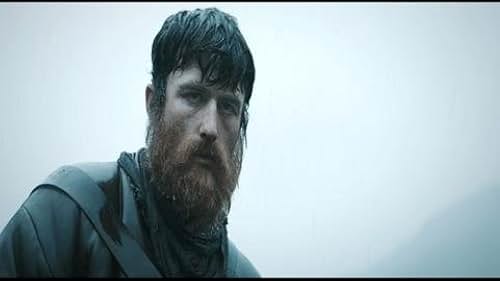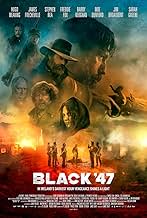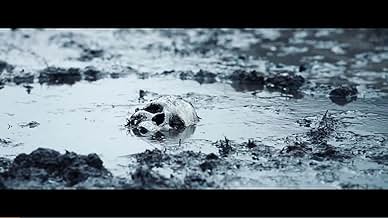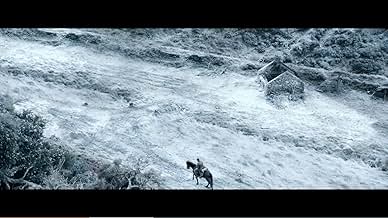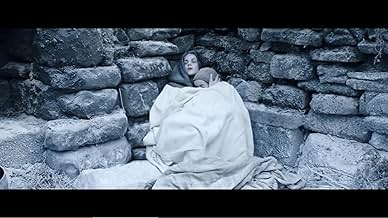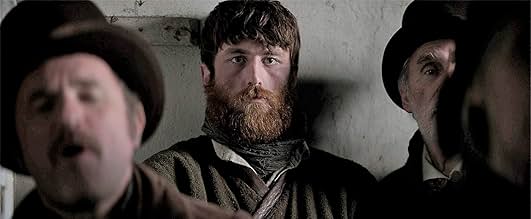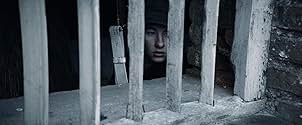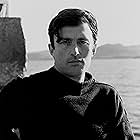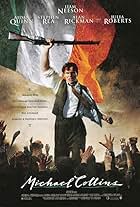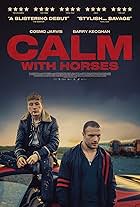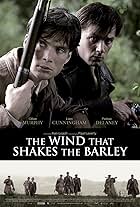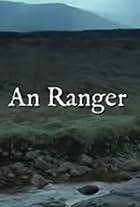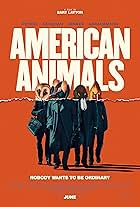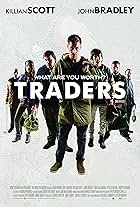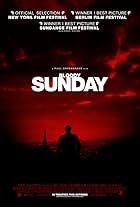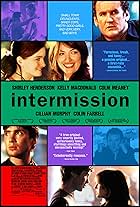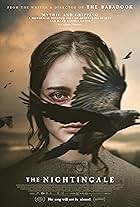Set in Ireland during the Great Famine, the drama follows an Irish Ranger who has been fighting for the British Army abroad, as he abandons his post to reunite with his family.Set in Ireland during the Great Famine, the drama follows an Irish Ranger who has been fighting for the British Army abroad, as he abandons his post to reunite with his family.Set in Ireland during the Great Famine, the drama follows an Irish Ranger who has been fighting for the British Army abroad, as he abandons his post to reunite with his family.
- Awards
- 2 wins & 8 nominations
Storyline
Did you know
- TriviaThe term 'Black 47' refers to the summer of 1847, when the Irish potato famine was at its height and hundreds of thousands of people died from starvation.
- GoofsFeeney is described as a Connaught Ranger who served in the Afghan War and then deserted in Calcutta before making his way home. However, the 88th Regiment of Foot (Connaught Rangers) were based in Malta during the Anglo-Afghan War and went to the West Indies in 1847. The Anglo-Afghan War was fought by soldiers of the British East India Company, not by the regular British Army.
- Quotes
Lord Kilmichael: The peasants are all the same. No appreciation of beauty.
Conneely: Beauty would be held in much higher regard, Sir, if it could be eaten.
- ConnectionsReferenced in Happy!: 19 Hours and 13 Minutes (2019)
Featured review
I'm not going to lie - I fully expected to hate Black '47. The trailer was awful, making it look like a generic action flick; several colleagues saw the screening at ADIFF and were decidedly unimpressed; I thought most of the film was in English, which rubbed me up the wrong way. Mainly though, I was just fulfilling my God-given right as an Irish person - being cankerous for no earthly reason whatsoever. However, because I was expecting to hate it, when I discovered that it's actually quite good, it led to me thoroughly enjoying it. Easily the most hyped and anticipated Irish film of the last decade or so, Black '47 is proudly advertised as the "first film about the Great Famine". And were this true, it would undoubtedly occupy a canonical place in Irish artistic output. However, there is one vital factor that everyone really needs to know before seeing it - it isn't the first film about the Famine. It's the first film set during the Famine, but it isn't about the Famine.
Written by Lance Daly, P.J. Dillon, and Pierce Ryan, and directed by Daly, this is a genre film, a revenge western set against the backdrop of the Famine. The Famine is not the film's central theme, nor does it attempt to engage with it on a national scale. If you accept that, and don't expect to see Cecil Woodham-Smith transposed to the screen, there's actually quite a lot here to admire.
It is winter 1847, two years since blight caused the failure of the potato crop on which large portions of the country's poor depend. Having deserted from the British Army, Martin Feeney (James Frecheville) returns home to Connemara unaware of the state of the country. Travelling to his home, Feeney learns his immediate family is dead and his sister-in-law Ellie (Sarah Greene), and her three children are living in an abandoned cottage, Although Feeney persuades Ellie to join him in emigrating, the following day, an eviction party arrives with orders to eject the family and burn the property. Things soon turn violent, and Feeney is arrested, although he quickly escapes, and sets about exacting revenge those he feels wronged him. Meanwhile, learning of Feeney's escape, the British Army send a team after him, led by Feeney's former commander, the disillusioned Hannah (Hugo Weaving).
The Famine is the single most significant event in Irish history; a cataclysmic tragedy on a biblical scale. Between 1845 and 1852, around one-and-a-half million people died and nearly two million emigrated, reducing the populace by roughly 25% (1847 is known as "Black '47" because both the death and emigration rates were at their highest). The Irish language was laid to waste; the myths and sagas of Irish folklore were forgotten for decades; the proud tradition of Irish bards changed forever, with thousands of songs lost; Irish literature slowed down to a trickle; and hatred of the English occupiers became more galvanised than at any point in the previous 700 years of their presence.
Considering how important an event this is in Irish history, it is conspicuous by its absence from the national cinema. However, how does one fashion a narrative which could possibly convey the bleakness of the Famine? Maybe in this era of long-form narrative on TV, there's a possibility of doing something Famine-related, but condensing the most significant seven years in Irish history into a two (or three, or four) hour film is nigh-on impossible, not to mention the sheer unrelenting misery one would need to put on screen. And so, Black '47 has no intentions of dealing with the Famine on that kind of scale. This is a genre piece, it's a western, a revenge thriller.
Indeed, using the Famine as a backdrop for a genre exercise is probably a wise choice - it allows limited engagement by way of a plot-driven story, without setting up massive expectations (advertising hyperbole aside) and unconquerable thematic hurdles. No Famine narrative could ever depict a story in which a protagonist rights all the wrongs of Ireland, because no such person existed. However, the relatively contained story of Feeney's revenge is more than aware of that. He is never painted as someone out to liberate the country, spurred on by the wrongs done to him personally. He wants revenge on the people who wronged him; he has no aspirations of saving Ireland, and is powerless to do anything on a larger socio-economic canvas. The film never lets the audience forget this, whether it be shots of Feeney emotionlessly riding past starving peasants on the roadside, or his invasion of a Protestant soup tent, where he eats his own fill and then leaves. He's not the avenging spirit of Ireland made flesh, he's not Cú Chulainn, or one of the Tuatha Dé Danann. This is not a piece of nationalist wish fulfilment, and it makes no claim to be.
In terms of how the film represents the Famine, apart from its importance to the plot, Daly depicts a number of "quintessential Famine images". These include one of the first shots in the film, which shows a skull sinking into the wet mud, representing the dead and their connection to the land (a little on the nose, but it does the job); when Ellie first appears, she looks like Caitlín Ní Uallacháin, the implication being that Ireland itself is literally dying; when she and her children are evicted, the scene is very much an archetype of such evictions - women and children crying, men being restrained, the thatched roof of a cottage burning, callous bailiffs; a Catholic priest warning the starving peasants not to "take the soup"; peasants taking the soup; grain being stockpiled for export to England; bedraggled peasants huddled at the gates of an affluent estate, begging the rich occupants to give them food; multiple references to emigration. In point of fact, although the Famine is essentially just background, Daly works hard to make sure the viewer never forgets what's happening beyond the edges of the frame.
One of the reasons I thought I was going to hate Black '47 was because I thought it was entirely in English, which would have been patently ridiculous. Perhaps the most long-lasting effect of the Famine is that it decimated Gaeilge, the Irish language. The Famine is why this review is in English, and why I can speak only a few sentences in my native tongue. In seven years, the Famine did what the English couldn't manage in 700 - it destroyed that which defined us as a people, our very national identity. However, not only are large sections of Black '47 in Irish, the film actually uses the Irish language and the attempts to suppress it as an important recurring motif. For example, Feeney speaks both English and Irish, but he makes a conscious decision to only speak Irish, even when talking to non-Irish speakers. The film also shows a judge erupting in anger as peasants in his courtroom, unable to speak English, begin to converse in Irish, whilst an English lord refers to Gaeilge as "that aboriginal gibberish". However, the most important scene concerning the Irish language is in the Protestant soup kitchen. When the priest asks a peasant his name, the man replies "Séamus Ó Súilleabháin". The priest turns around to a translator, who responds, "James Sullivan". This speaks to the Anglicisation of Irish place names by the British (Béal an Átha became Ballina, Dún Dealgan became Dundalk, Trá Lí became Tralee, etc), itself an attempt to destroy the language and undermine our sense of place. Daly never allows the devastating effect the Famine had on the language to fade too far into the background, and the narrative is all the better for it.
Of course, all of this is not to say the film is perfect. Composer Brian Byrne's score, which features a heavy usage of uilleann pipes, is decent, but overly didactic. Additionally, the character of Lord Kilmichael (Jim Broadbent) is something of a clichéd, token villain. Daly also has a slight tendency to unsuccessfully mix naturalism with stylisation, perhaps most obvious in the use of intentionally artificial looking matte paintings as backgrounds in some of the panoramic scenes. Whilst the intention behind this was most likely to try to evoke the look of old sepia photographs, contemporary audiences used to photorealistic CGI will probably interpret it as cheap effects work, which is a shame, and does the film no favours. Finally, if there's one thing I was surprised that wasn't mentioned, especially given all the references to emigration, it would be the coffin ship, the image of which is a permanent component of the Famine's legacy in Ireland.
However, all things considered, this is a strong and reasonably important piece of filmmaking. Yes, it's essentially just a revenge western, and yes, in that sense, it's nothing overly special; there are a hundred films along these lines, and several of them are better than Black '47. However, Daly allows the Famine background to come to the fore sufficiently so that we never forget when and where we are, and because of this, it's undoubtedly an important film. Mixing the historical with the generic just enough so that each informs the other without either becoming (too) diluted, it's not the first "Famine film", but it is a very decent, honest, and respectful attempt to put something (anything) of that great tragedy on screen.
It is winter 1847, two years since blight caused the failure of the potato crop on which large portions of the country's poor depend. Having deserted from the British Army, Martin Feeney (James Frecheville) returns home to Connemara unaware of the state of the country. Travelling to his home, Feeney learns his immediate family is dead and his sister-in-law Ellie (Sarah Greene), and her three children are living in an abandoned cottage, Although Feeney persuades Ellie to join him in emigrating, the following day, an eviction party arrives with orders to eject the family and burn the property. Things soon turn violent, and Feeney is arrested, although he quickly escapes, and sets about exacting revenge those he feels wronged him. Meanwhile, learning of Feeney's escape, the British Army send a team after him, led by Feeney's former commander, the disillusioned Hannah (Hugo Weaving).
The Famine is the single most significant event in Irish history; a cataclysmic tragedy on a biblical scale. Between 1845 and 1852, around one-and-a-half million people died and nearly two million emigrated, reducing the populace by roughly 25% (1847 is known as "Black '47" because both the death and emigration rates were at their highest). The Irish language was laid to waste; the myths and sagas of Irish folklore were forgotten for decades; the proud tradition of Irish bards changed forever, with thousands of songs lost; Irish literature slowed down to a trickle; and hatred of the English occupiers became more galvanised than at any point in the previous 700 years of their presence.
Considering how important an event this is in Irish history, it is conspicuous by its absence from the national cinema. However, how does one fashion a narrative which could possibly convey the bleakness of the Famine? Maybe in this era of long-form narrative on TV, there's a possibility of doing something Famine-related, but condensing the most significant seven years in Irish history into a two (or three, or four) hour film is nigh-on impossible, not to mention the sheer unrelenting misery one would need to put on screen. And so, Black '47 has no intentions of dealing with the Famine on that kind of scale. This is a genre piece, it's a western, a revenge thriller.
Indeed, using the Famine as a backdrop for a genre exercise is probably a wise choice - it allows limited engagement by way of a plot-driven story, without setting up massive expectations (advertising hyperbole aside) and unconquerable thematic hurdles. No Famine narrative could ever depict a story in which a protagonist rights all the wrongs of Ireland, because no such person existed. However, the relatively contained story of Feeney's revenge is more than aware of that. He is never painted as someone out to liberate the country, spurred on by the wrongs done to him personally. He wants revenge on the people who wronged him; he has no aspirations of saving Ireland, and is powerless to do anything on a larger socio-economic canvas. The film never lets the audience forget this, whether it be shots of Feeney emotionlessly riding past starving peasants on the roadside, or his invasion of a Protestant soup tent, where he eats his own fill and then leaves. He's not the avenging spirit of Ireland made flesh, he's not Cú Chulainn, or one of the Tuatha Dé Danann. This is not a piece of nationalist wish fulfilment, and it makes no claim to be.
In terms of how the film represents the Famine, apart from its importance to the plot, Daly depicts a number of "quintessential Famine images". These include one of the first shots in the film, which shows a skull sinking into the wet mud, representing the dead and their connection to the land (a little on the nose, but it does the job); when Ellie first appears, she looks like Caitlín Ní Uallacháin, the implication being that Ireland itself is literally dying; when she and her children are evicted, the scene is very much an archetype of such evictions - women and children crying, men being restrained, the thatched roof of a cottage burning, callous bailiffs; a Catholic priest warning the starving peasants not to "take the soup"; peasants taking the soup; grain being stockpiled for export to England; bedraggled peasants huddled at the gates of an affluent estate, begging the rich occupants to give them food; multiple references to emigration. In point of fact, although the Famine is essentially just background, Daly works hard to make sure the viewer never forgets what's happening beyond the edges of the frame.
One of the reasons I thought I was going to hate Black '47 was because I thought it was entirely in English, which would have been patently ridiculous. Perhaps the most long-lasting effect of the Famine is that it decimated Gaeilge, the Irish language. The Famine is why this review is in English, and why I can speak only a few sentences in my native tongue. In seven years, the Famine did what the English couldn't manage in 700 - it destroyed that which defined us as a people, our very national identity. However, not only are large sections of Black '47 in Irish, the film actually uses the Irish language and the attempts to suppress it as an important recurring motif. For example, Feeney speaks both English and Irish, but he makes a conscious decision to only speak Irish, even when talking to non-Irish speakers. The film also shows a judge erupting in anger as peasants in his courtroom, unable to speak English, begin to converse in Irish, whilst an English lord refers to Gaeilge as "that aboriginal gibberish". However, the most important scene concerning the Irish language is in the Protestant soup kitchen. When the priest asks a peasant his name, the man replies "Séamus Ó Súilleabháin". The priest turns around to a translator, who responds, "James Sullivan". This speaks to the Anglicisation of Irish place names by the British (Béal an Átha became Ballina, Dún Dealgan became Dundalk, Trá Lí became Tralee, etc), itself an attempt to destroy the language and undermine our sense of place. Daly never allows the devastating effect the Famine had on the language to fade too far into the background, and the narrative is all the better for it.
Of course, all of this is not to say the film is perfect. Composer Brian Byrne's score, which features a heavy usage of uilleann pipes, is decent, but overly didactic. Additionally, the character of Lord Kilmichael (Jim Broadbent) is something of a clichéd, token villain. Daly also has a slight tendency to unsuccessfully mix naturalism with stylisation, perhaps most obvious in the use of intentionally artificial looking matte paintings as backgrounds in some of the panoramic scenes. Whilst the intention behind this was most likely to try to evoke the look of old sepia photographs, contemporary audiences used to photorealistic CGI will probably interpret it as cheap effects work, which is a shame, and does the film no favours. Finally, if there's one thing I was surprised that wasn't mentioned, especially given all the references to emigration, it would be the coffin ship, the image of which is a permanent component of the Famine's legacy in Ireland.
However, all things considered, this is a strong and reasonably important piece of filmmaking. Yes, it's essentially just a revenge western, and yes, in that sense, it's nothing overly special; there are a hundred films along these lines, and several of them are better than Black '47. However, Daly allows the Famine background to come to the fore sufficiently so that we never forget when and where we are, and because of this, it's undoubtedly an important film. Mixing the historical with the generic just enough so that each informs the other without either becoming (too) diluted, it's not the first "Famine film", but it is a very decent, honest, and respectful attempt to put something (anything) of that great tragedy on screen.
Details
- Release date
- Countries of origin
- Official sites
- Languages
- Also known as
- Чорний 47-й
- Filming locations
- Production companies
- See more company credits at IMDbPro
Box office
- Gross US & Canada
- $57,520
- Opening weekend US & Canada
- $8,600
- Sep 30, 2018
- Gross worldwide
- $2,073,063
- Runtime1 hour 40 minutes
- Color
- Aspect ratio
- 2.35 : 1
Contribute to this page
Suggest an edit or add missing content

